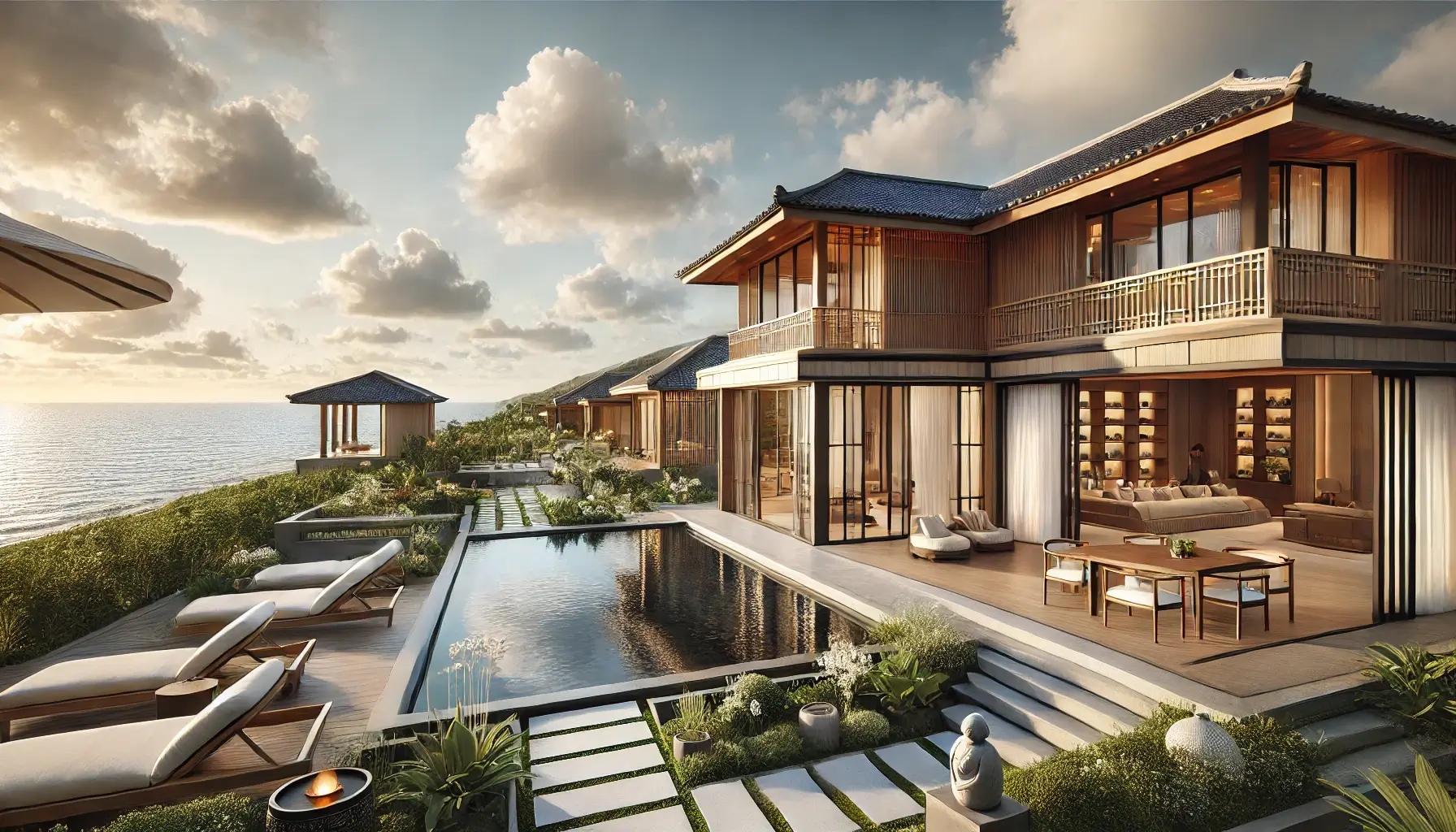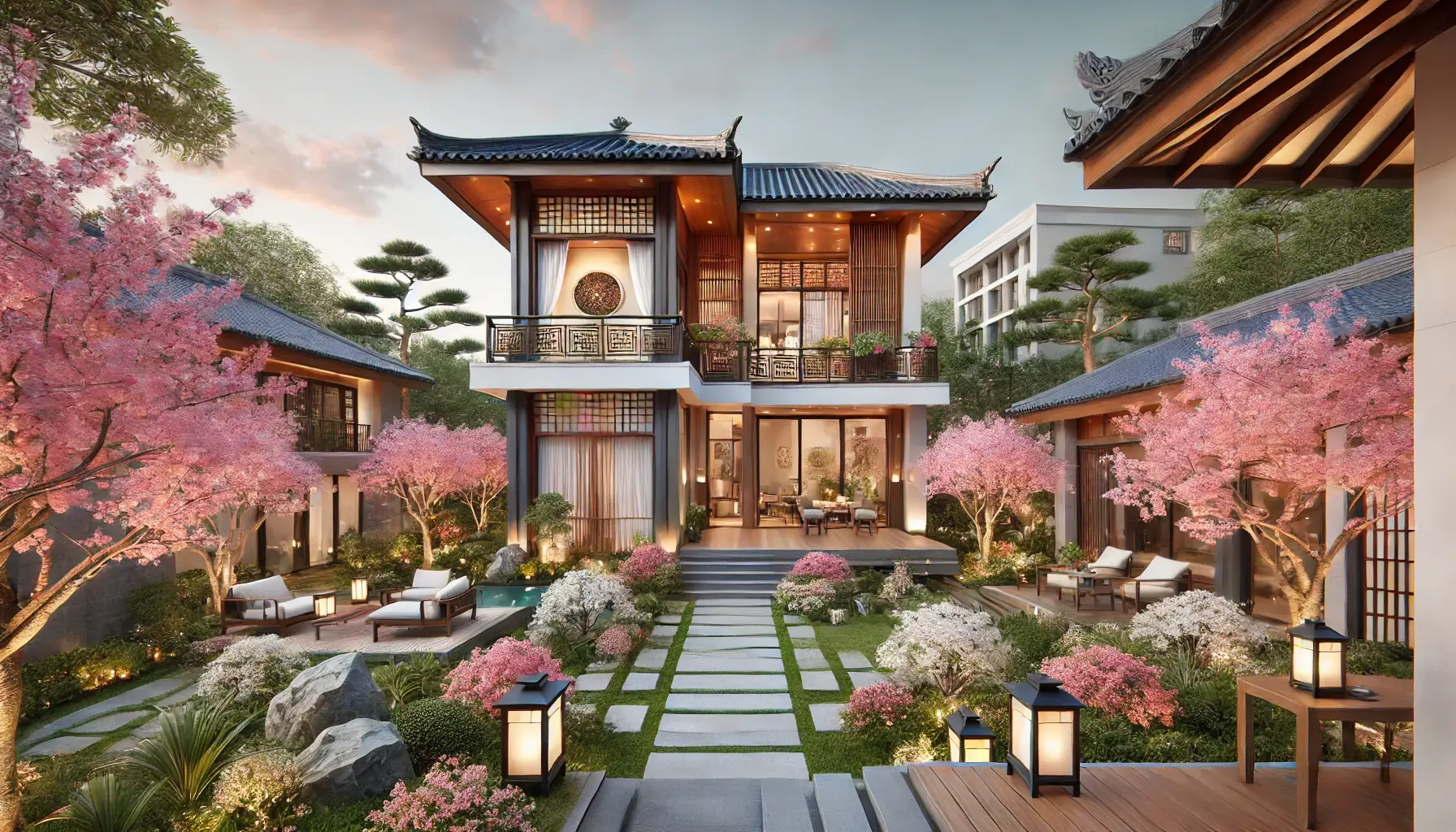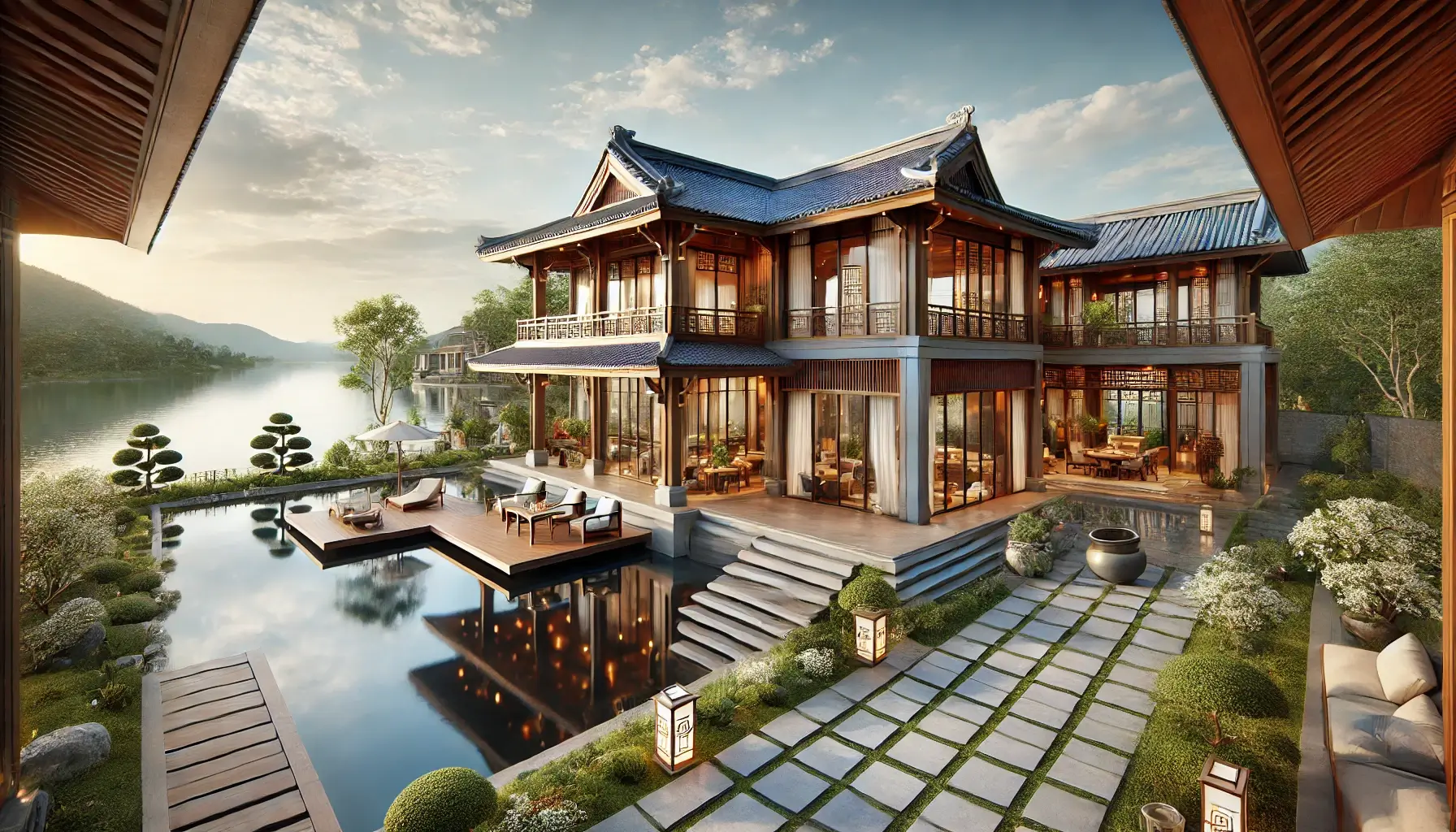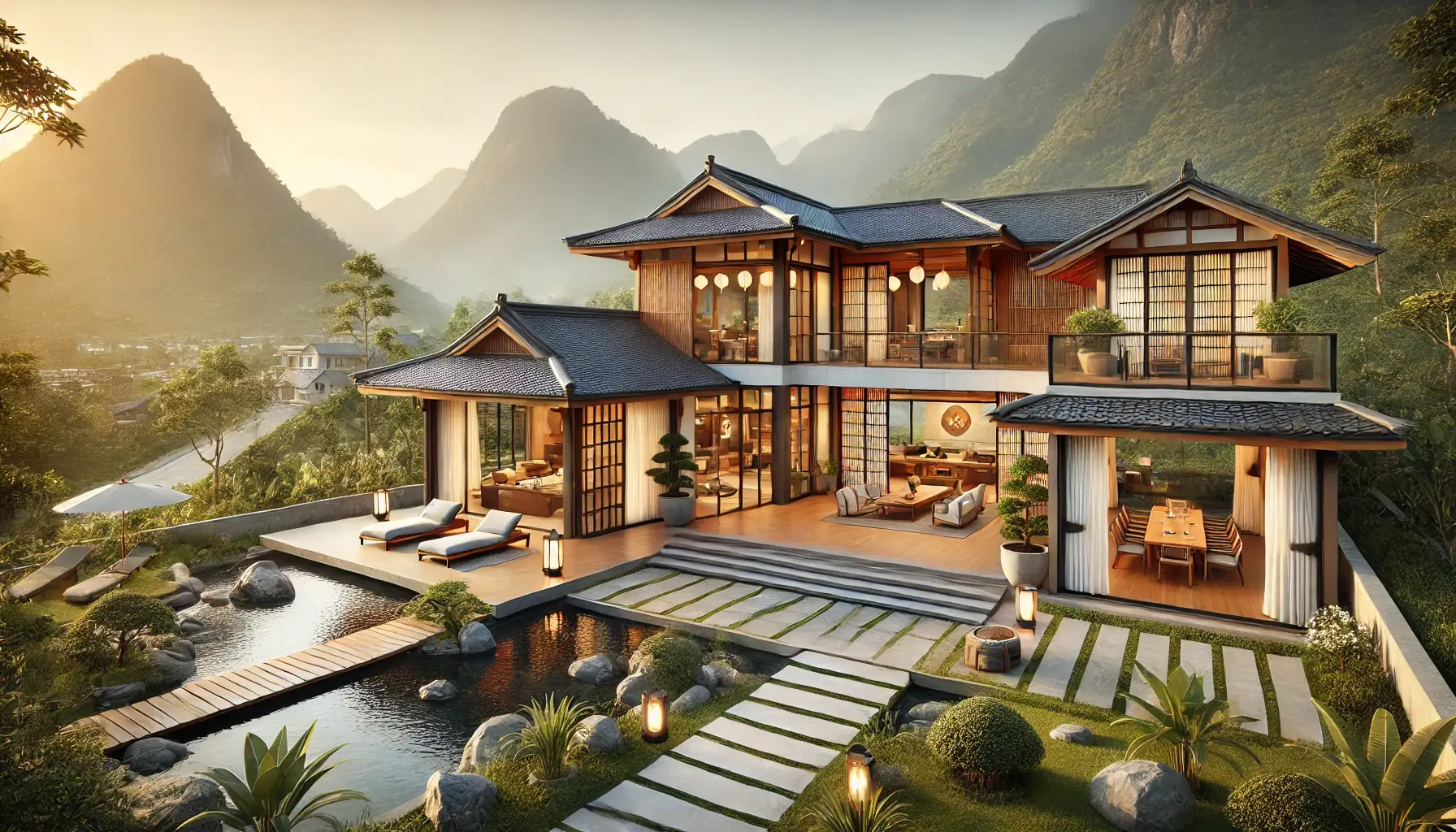Japanese-style Villas: Advantages & Design Models
Japanese-style villas are a harmonious blend of traditional and modern architecture, offering a peaceful living space close to nature. Join Ngọc Thành Vinhomes as we explore the unique beauty of this style!
Nội dung bài viết
ToggleWhat is a Japanese-style Villa?
Origin and Meaning of Japanese-style Villas
Japanese architectural style originated from traditional houses like Minka and ancient palaces, heavily influenced by Zen philosophy and Shintoism. Japanese-style villas are not just places to live but spaces where people can seek balance and peace of mind. Every design detail aims to achieve harmony with nature, reflecting the culture and minimalist, yet refined lifestyle of the Japanese. These villas offer a living space that not only pleases the eye but also nurtures the soul, helping the owner find peace and relaxation after the chaos of everyday life.
Key Architectural and Interior Features
Japanese-style villas often have low structures, wide-tiled roofs, and natural wood detailing. Interior spaces emphasize simplicity and functionality, using materials like wood, bamboo, stone, and traditional paper. Natural light is maximized to create a spacious and nature-connected atmosphere. The color palette is usually composed of neutral, soft tones like white, beige, brown, and gray, creating an elegant and calming living space.

Exterior Architectural Beauty
Signature Roof Design
The roof is one of the most important highlights of Japanese-style villas. It usually features a steep slope, often made of tiles or other natural materials like straw or leaves, creating an aesthetic that is both elegant and connected to nature. The wide roof design also helps protect the house from sun and rain while providing shade to the surrounding area. This type of roof not only holds high aesthetic value but also demonstrates the skillful craftsmanship of traditional Japanese construction techniques.
Wide Open Windows and Doors
Japanese-style villas often have large windows and doors, sometimes featuring traditional Shoji sliding doors made of wooden frames and opaque paper. This allows natural light to flood the interior while maintaining a seamless connection between indoor and outdoor spaces. Shoji doors also allow for light adjustment and privacy when needed, creating a flexible and comfortable living environment.
Natural Materials: Wood, Bamboo, Stone
Wood is the primary material in Japanese villa architecture, from the house frame, beams, and columns to floors and ceilings. Commonly used woods include cedar, pine, and oak, which bring warmth and a connection to nature, while also reflecting the house’s durability and stability. Bamboo is also widely used in decorative and interior details, adding softness and uniqueness to the space. Natural stone is often used for paving garden paths, building walls, or creating outdoor features, contributing to a rustic and nature-friendly aesthetic.
Interior Spaces Rich in Zen Influence
Simplicity and Elegance in Every Detail
Japanese villa interiors focus on minimalism, eliminating unnecessary details and keeping only the essentials. Every item is carefully selected, with an emphasis on quality and aesthetics. The interior is arranged with elegance, creating a peaceful and relaxing atmosphere. The harmonious combination of light, color, and materials creates a light, tranquil space that helps homeowners unwind and regain balance after a long day.
Traditional Furniture: Low Tea Tables, Tatami Mats
Low tea tables and Tatami mats are two must-have pieces of furniture in Japanese villas. Low tea tables are typically placed at the center of the living room, where the family gathers to chat and enjoy tea. Tatami mats, laid on the floor, offer a soft, warm surface and are a distinctive feature of Japanese interiors. Other furniture such as cabinets, shelves, and beds are also often made of natural wood with simple, compact, and multifunctional designs.
Maximizing Natural Light
Natural light plays a crucial role in Japanese villa interior design. Large windows, Shoji sliding doors, and skylights allow light to flood the space, creating an airy, nature-connected atmosphere. Using natural light not only helps save energy but also provides a comfortable and pleasant living environment.

Gardens – The Harmony Between Humans and Nature
Signature Elements: Koi Ponds, Bonsai Trees, Rocks
Gardens are an essential part of Japanese villas. Traditional Japanese gardens often feature Koi ponds, meticulously trimmed bonsai trees, and carefully arranged rocks. Water, plants, and stone symbolize the three basic elements of nature, creating balance and harmony in the space. Additionally, Japanese gardens may include elements like stone lanterns, wooden bridges, or small waterfalls, creating a picturesque miniature landscape.
The Role of Japanese Gardens in Overall Architecture
Japanese gardens are not only places to relax and admire but also serve as a bridge between humans and nature. They bring peace and serenity, helping people reconnect with their inner balance. Japanese garden design reflects the philosophy of living close to nature and respecting the changing seasons. Every season brings a new beauty to the garden, from the cherry blossoms in spring to the red maple leaves in autumn, offering delightful experiences for the homeowner.
Advantages and Disadvantages of Choosing a Japanese-style Villa

Aesthetic and Spiritual Benefits
Japanese-style villas provide a living space that is both elegant, peaceful, and closely connected to nature. The minimalist design eliminates distractions, creating an environment conducive to focus and relaxation. Living in such a space can bring numerous mental and physical health benefits, reduce stress, enhance creativity, and foster a sense of well-being.
Challenges and Considerations
Building a Japanese-style villa can be more expensive than other styles due to the use of natural materials and the high level of craftsmanship required, especially for handcrafted elements like Shoji doors or garden features. Additionally, maintaining and caring for the garden requires time and effort to preserve its natural beauty and harmony.
The Trend of Japanese-style Villas in Vietnam

Popularity and Notable Projects
Japanese-style villas are increasingly popular in Vietnam, particularly in new urban areas and high-end resorts. Notable projects include Ecopark (Hưng Yên) and Vinhomes Riverside (Hanoi), where Japanese-style villas are built with green spaces, lakes, and trees, offering an ideal living environment for residents.
Why Vietnamese People Love This Style
Vietnamese people are increasingly drawn to green living spaces, close to nature, and appreciate simplicity and elegance. Japanese-style villas meet these needs while adding a unique and distinctive charm to the home. Additionally, the influence of Japanese culture through films, manga, and tourism has contributed to the growing fondness for this style in Vietnam.
Advice from Ngọc Thành Vinhomes
Japanese-style villas are the perfect choice for those who love harmony with nature and seek a peaceful, elegant living space. If you’re considering building such a home, thoroughly research the characteristics of this style and choose a reputable design and construction company to create your dream living space. Furthermore, learning about Japanese culture and lifestyle will help you appreciate the beauty and meaning behind each design element.
If you have any questions or concerns about Japanese-style villas, feel free to leave a comment below. Ngọc Thành Vinhomes is always ready to answer your questions and share more useful information. Don’t forget to visit vinhomesplace.com to discover more valuable knowledge about real estate and lifestyle.














